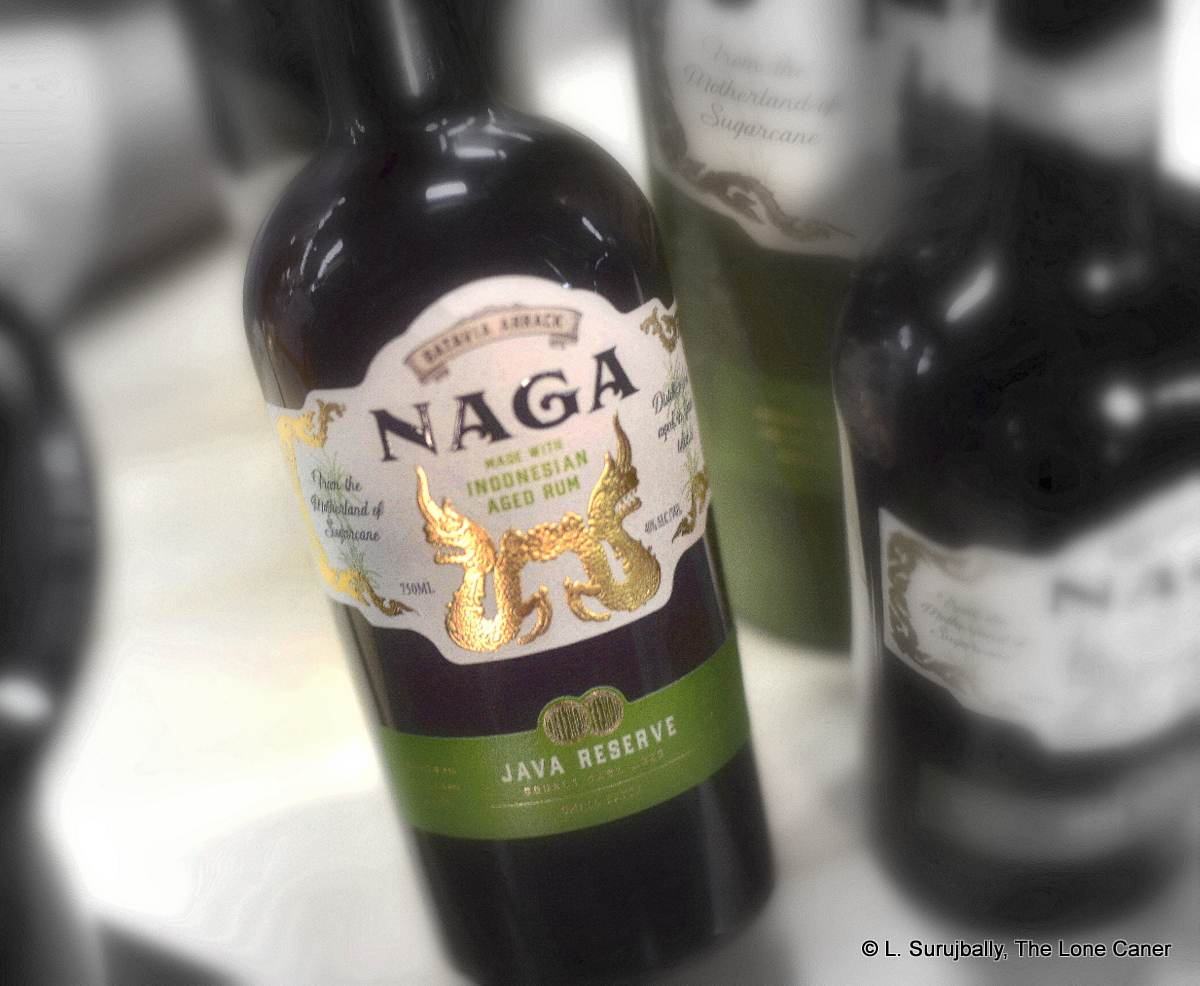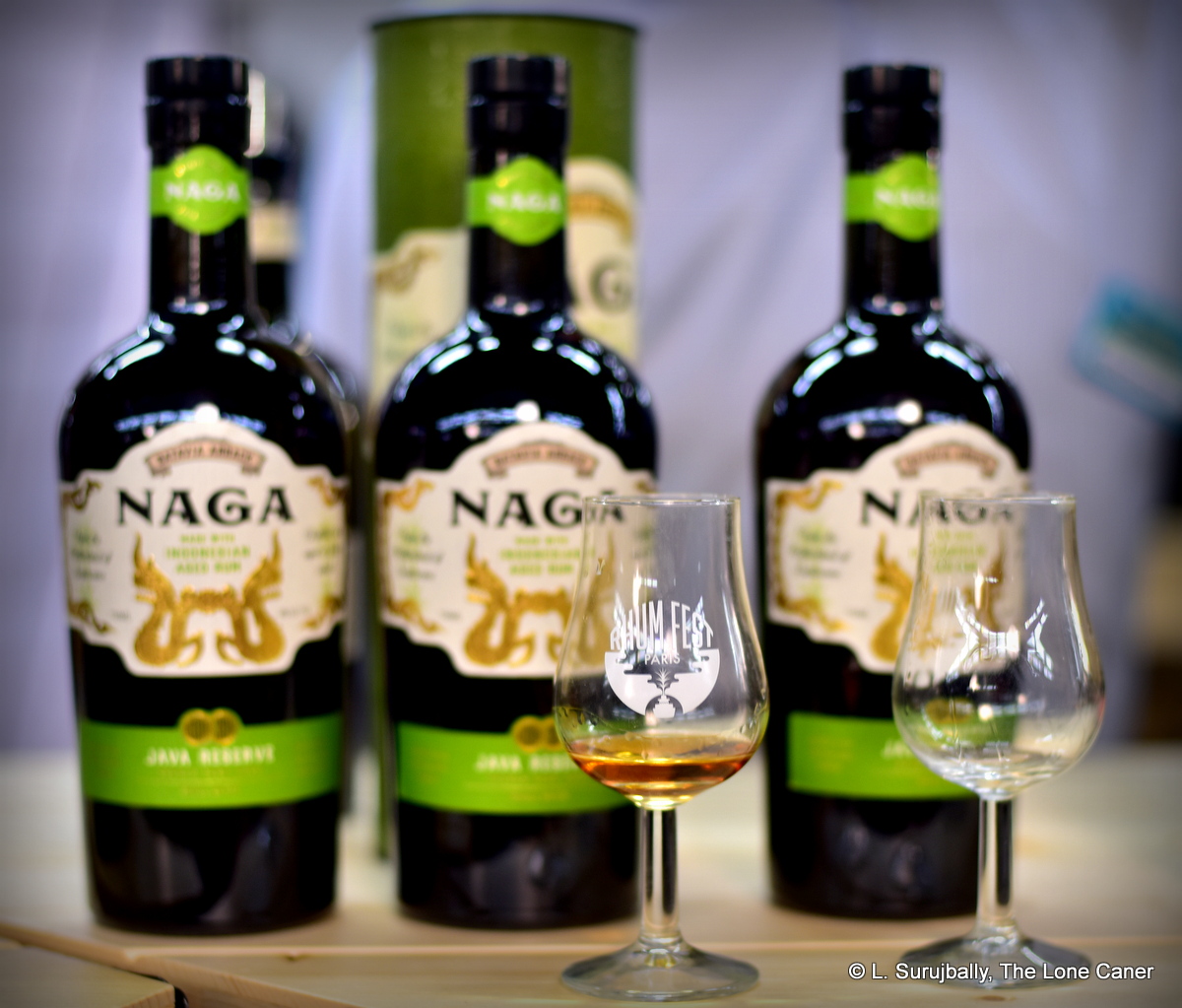
Everything you research on Naga is likely to make you rend your robes with frustration at what little you do manage to dig up. Yet paradoxically, everything you do find out about the rum itself seems guaranteed to keep you reading, and make you buy it, if no other reason than because it seems so damned interesting. The label seems designed specifically to tantalize your curiosity. Perusing it, you can with equal justification call it “Naga Batavia Arrack” (“made with Indonesian aged rum” says the script, implying there it’s arrack plus rum), or “Naga Double Cask rum” or “Naga Java Reserve Rum” or simply go with the compromise route. And each of those would, like the mythical elephant to the blind men, be somewhat correct.
It’s a Batavia Arrack from Indonesia, which means it a rum made from molasses and a red rice yeast derivative (just like the arrack made by By the Dutch). Both Naga’s 38% version with a different label, and this one, are a blend of distillates: just over half of it comes from pot stills (“Old Indonesian Pot Stills” puffs the less-than-informative website importantly, never quite explaining what that means) with a strength of 65% ABV; and just under half is 92% ABV column still spirit (the ratios are 52:48 if you’re curious). The resultant blend is then aged for three years in teak barrels and a further four years in ex-bourbon barrels, hence the moniker “double aged”. In this they’re sort of channelling both the Brazilians with their penchant for non-standard woods, and Foursquare with their multiple maturations
Whether all this results in a rum worth acquiring and drinking is best left up to the individual. What I can say is that it demonstrates both a diversity of production and a departure from what we might loosely term “standard” — and is a showcase why (to me) rum is the most fascinating spirit in the world….but without the rum actually ascending to the heights of must-have-it-ness and blowing my hair back. In point of fact, it is not on a level with the other two Indonesian rums I’ve tried before, the Compagnie des Indes Indonesia 2004 10 YO and the By The Dutch Batavia Arrack.

Follow me through the tasting: the nose is initially redolent of brine and olives, and of cardboard, and dry and musty rooms left undusted too long. That’s the beginning – it does develop, and after some time you can smell soy, weak vegetable soup, stale maggi cubes, and a faint line of sweet teriyaki, honey, caramel and vanilla. And, as a nod to the funkytown lovers out there, there is a hint of rotten fruits, acetones and spoiled bananas as well, as if a Jamaican had up and gone to Indonesia to take up residence in the bottle…and promptly fell asleep there.
Palate. It was the same kind of delicate and light profile I remembered from the other two arracka mentioned above. Still, the texture was pleasant, it was pleasantly — but not excessively — sweet, and packed some interesting flavours in its suitcase: salt caramel ice cream, dill and parsley, cinnamon,sharp oak tannins, leather, some driness and musky notes, and a sharp fruity tang, both sweet and rotten at the same time – not very strong, but there nevertheless, making itself felt in no uncertain terms. Finish was relatively short, mostly light fruits, some brine, mustiness and a trace of rubber.
Summing up. On the negative side, there is too little info available online or off for the hard facts — what an “Indonesian” pot still actually is, where the distillery is, who owns it, when was the company established, the source of the molasses and so on…this erodes faith and trust in any proclaimed statements and in this day and age is downright irritating. Conversely, listing all the pluses: it has a genuinely nice and relatively sweet mouthfeel, is gentle, tasty, spicy, somewhat complex and different enough to excite, while still being demonstrably a rum…of some kind. It just didn’t entirely appeal to me.
Because I found that overall, it lacked good integration. The pot still portion careened into the column still part of the blend and neither came out well from the encounter; the esters, acidity and tartness really did not accentuate or bring out the contrasting muskier, darker tones well at all, and it just seemed a bit confused….first you tasted one thing, then another and the balance between the components was off. Also, the wood was a shade too bitter – maybe that was the teak or maybe it was the liveliness of the ex-bourbon barrels. Whatever the case, the overall impression was of a product that somehow failed to cohere.
I’m fully prepared to accept that a rum from another part of the world with which we lack familiarity caters to its own audience, and is supposed to be somewhat off the wall, somewhat at right angles to conventional tastes of bloggers like me who are raised on Caribbean fare and all its imitators. Yet even within that widely cast net, there’s stuff that works and stuff that doesn’t. This is one that falls in the middle – it’s nice enough, it kinda sorta works, but not completely and not so much that I’d rush out to get me another bottle.
(#623)(79/100)